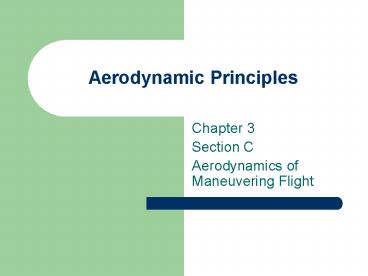Aerodynamic Principles PowerPoint PPT Presentation
1 / 28
Title: Aerodynamic Principles
1
Aerodynamic Principles
- Chapter 3
- Section C
- Aerodynamics of Maneuvering Flight
2
Climbing Flight
3
Climbing FlightSustained Vertical Flight
- Thrust-to-weight ratio greater than 1.1 to 1
- Wings supply no vertical lift
- Weight and drag opposed only by thrust
- F-16
4
Left-turning Tendencies
- High power, low airspeed
- Torque
- Gyroscopic precession
- Asymmetrical thrust
- Spiraling slipstream
5
Left-turning Tendencies Torque
- Newton For every action there is an equal and
opposite reaction - Propeller rotates clockwise causes torque which
tends to rotate airplane counterclockwise about
longitudinal axis
6
Left-turning Tendencies Torque
7
Left-turning Tendencies Gyroscopic Precession
- Prop has characteristics of gyroscope
- Rigidity in space
- Precession contributes to left turning tendency
- Precession is resultant reaction when force
applied to rim of rotating disk
8
Left-turning Tendencies Example Conventional
Gear Airplane
9
Left-turning Tendencies Asymmetrical thrust
P-factor
Airplane flown at high power and high angle of
attack Uneven angles of attack
between ascending and descending blades Unequal
thrust causes yaw to left
10
Left-turning Tendencies Design Considerations
- To counteract left-turning tendencies
- Metal tab on trailing edge of rudder
- Horizontally canted engine
- Engine turned slightly toward right
11
Left-turning Tendencies Spiraling Slipstream
- Slipstream from propeller wraps around fuselage
and hits left side of vertical fin - Causes tail to move right nose to yaw left
12
Descending Flight
- Weight has two components during descent
- perpendicular to flight path
- forward along flight path
13
Descending Flight Maximum Lift-to-Drag Ratio
- Specific angle of attack that generates the
greatest lift with least amount of drag - Used to measure gliding efficiency of AC
- Best glide angle
- Max gliding distance
14
Descending Flight Glide
- Best glide speed
- For given weight, L/Dmax corresponds to an
airspeed - Glide ratio
- distance aircraft will travel forward, without
power, in relation to altitude loss - best glide ratio available only with optimum
angle of attack associated with L/Dmax - Glide angle
- angle between glide path and horizon
15
Descending Flight Factors Affecting Glide
- Weight
- does not affect glide ratio
- heavier aircraft needs higher airspeed
- Configuration
- landing (more total drag) vs. clean (less total
drag) - Wind
- strong headwind reduces glide range, increase
airspeed - strong tailwind increases glide range, decrease
airspeed
16
Turning Flight
- Horizontal component of lift causes airplane to
turn - When vertical component of lift equals weight
aircraft will neither gain nor lose altitude
17
Turning FlightAdverse Yaw
- In a turn, outside wing produces more lift
- Induced drag is a product of creation of lift so
total drag increases - Causes yaw toward the outside of turn
- Use rudder in coordination with ailerons to
compensate for adverse yaw
18
Turning FlightOverbanking tendency
- Additional lift on outside wing tends to roll the
aircraft beyond the desired bank even after
neutralizing the controls - Use small amount of opposite aileron to maintain
the bank desired
19
Turning FlightRate and Radius of Turn
- Angle of bank and airspeed regulate both
- Rate
- Amount of time it takes to turn specific number
of degrees - Increase airspeed, same angle of bank rate is
slower - Increase angle of bank, same airspeed rate is
faster - Radius
- Horizontal distance used to complete a turn
- Increase airspeed, same angle of bank radius
larger - Increase angle of bank, same airspeed radius
smaller
20
Turning FlightRate and Radius of Turn
21
Turning FlightRate and Radius of Turn
22
Load Factor
- Ratio of
- Load supported by the wings
- to
- Actual weight of the aircraft and contents
- G-forces
- Feel heavier in turns
- Pilot input or environmental
23
Load FactorLoad Factor in Turns
- Load factor increases as angle of bank increases
- Compensate for apparent increase in weight and
loss of vertical lift in turn by increasing angle
of attack with back pressure. - During constant altitude turns, relationship
between load factor and bank angle is same for
all aircraft See chart on Page 3-60
24
Load FactorLoad Factor and Stall Speed
- Increasing load factor will cause and airplane to
stall at a higher speed Chart Page 3-61 - Stalls that occur with G-forces being applied are
accelerated stalls - Show that the reason for stall is exceeding
critical angle of attack, not airspeed
25
Load FactorLimit Load Factor
- Amount of stress or load factor that an aircraft
can withstand before structural failure - Function of design
- Established by category normal, utility,
acrobatic - In POH
26
Load FactorLimit Load Factor
27
Load FactorDesign Maneuvering Speed Va
Max speed at which you can use full, abrupt
control movement without over stressing the
airframe
28
Load FactorDesign Maneuvering Speed Va
- Va not normally marked on airspeed indicator
- Changes with weight
- Found in POH and/or placard
- The amount of excess load that can be imposed on
an airframe depends on the aircrafts speed

